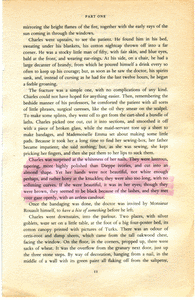KIVLAND, Sharon (2013). The Nabokov Paper An experiment in novel reading. In: The Nabokov Paper. York, UK, information as material, 78-81. [Book Section]
Documents
7556:15150
7556:15151
Abstract
A PROJECT BY Kate Briggs and Lucrezia Russo
PUBLISHED BY
information as material
WITH WORK BY
Graham Allen, James Arnett, Abraham Asfaw, Anne Attali, Katarzyna Bazarnik, Derek Beaulieu, Paul Becker, Christian Bök, Shanna Bosley, Stephen Bury, Chloe Briggs, Kate Briggs, Maurice Carlin, Jennifer Carr, Guillaume Constantin, Jamie Crewe, Véronique Devoldère, Lucia della Paolera, Craig Dworkin, Zenon Fajfer, Helen Frank, Céline Guyot, John Hamilton, Sharon Kivland, Gianni Lavacchini, Anna-Louise Milne, Forbes Morlock, Simon Morris, Amy Pettifer, Lucrezia Russo, Olivia Sautreuil, Nick Thurston, Jane Topping, Madeleine Walton, Patrick Wildgust, Robert Williams and Jack Aylward-Williams, Sarah Wood, Gillian Wylde
The Nabokov Paper is an experiment in novel-reading. The project takes as its starting point a now famous class taught during the 1950s by Vladimir Nabokov at Cornell University, New York State, entitled Literature 311-312: Masters of European Fiction. Nabokov’s approach to teaching literary reading was notoriously idiosyncratic. Convinced that one must teach the books themselves, not ideas or generalities, Nabokov would make diagrams of the floor plans of fictional buildings, map the routes taken by characters through the spaces of the novel, and draw items of clothing or furniture; he would also propose to track the course of a single letter, offer a visual representation of a stylistic device, and uncover what he called the mysteries of literary structures. His methods are striking for the range of gestures they call for in the name of good reading. The published Lectures on Literature (New York: Harcourt, 1980) concludes with an appendix of sample exam questions. Responding to those questions some sixty years after the fact offers a means to explore what Nabokov’s take on how to read might have to teach us today: about the novel, about how reading works across practices and disciplines, and about the past, present and future forms of literary criticism.
In April 2012, ten artists, eight writers, six university professors, three translators, two architects, a librarian, a curator, a graphic designer, an illustrator and a computer engineer each selected a question on one of seven course texts: Jane Austen’s Mansfield Park, Charles Dickens’s Bleak House, Gustave Flaubert’s Madame Bovary, Robert Louis Stevenson’s Dr Jekyll and Mr. Hyde, Franz Kafka’s “The Metamorphosis”, Marcel Proust’s Swann’s Way, and James Joyce’s Ulysses. The responses they turned in take the form of writing, drawing, painting, film, graphs, indexes, lists, maps, newly designed editions, objects, scale-models, a lecture and a reading game. This work, together with an introduction to the aims of the project, is presented in The Nabokov Paper – a publication that acts both as a record of the experiment and an invitation to undertake it again.
More Information
Statistics
Downloads
Downloads per month over past year
Metrics
Altmetric Badge
Dimensions Badge
Share
Actions (login required)
 |
View Item |


 Tools
Tools Tools
Tools![[thumbnail of Nabokov-cover-222x300.jpg]](https://shura.shu.ac.uk/7556/1.hassmallThumbnailVersion/Nabokov-cover-222x300.jpg)

![[thumbnail of page_ENGLISH_colour.jpg]](https://shura.shu.ac.uk/7556/2.hassmallThumbnailVersion/page_ENGLISH_colour.jpg)

